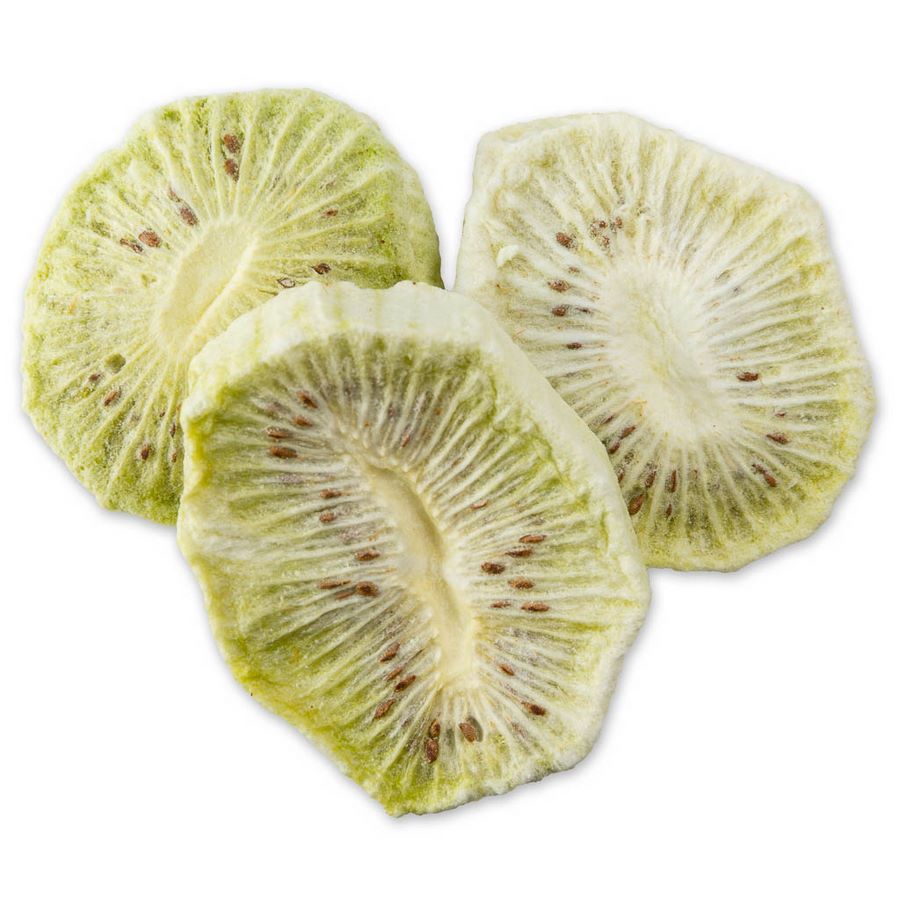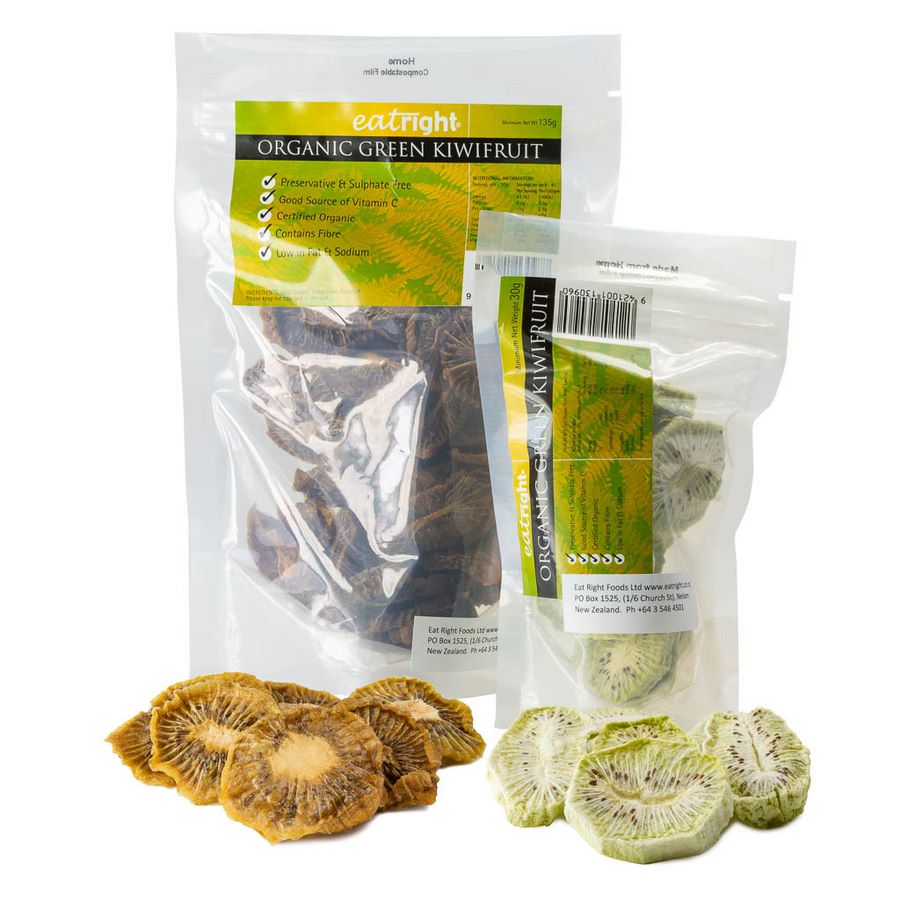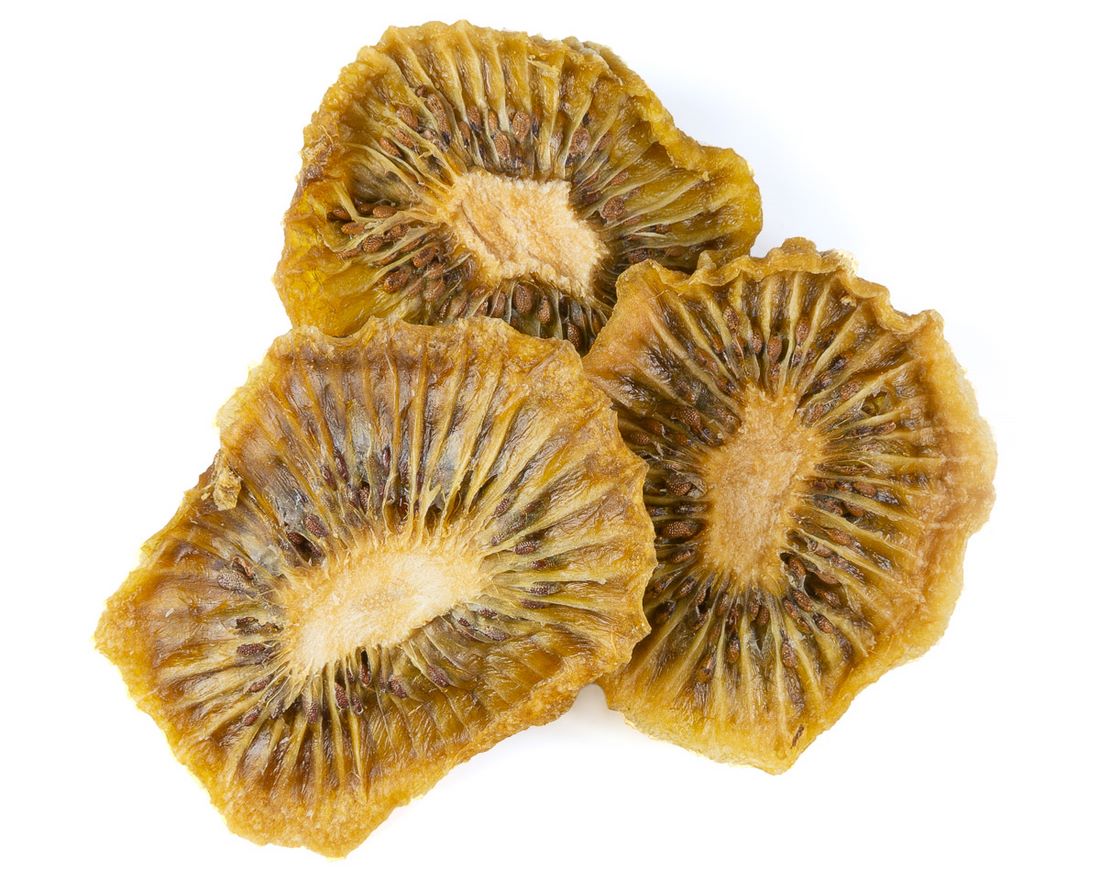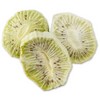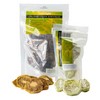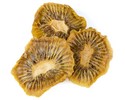EATRIGHT® GREEN Kiwi-Fruit Slices (ISO 17020, 17065) Organic, Dual Dry Options
A nutrient dense, superfruit, waterlessened, full-season-everyday-enabled EATRIGHT® product [1]. Green [kākāriki. 1. (verb) to be green (in colour)] kiwfruit [kiwi] [2] is of the highest fruit sources of vitamin K1 (phylloquinone) (5μg, 6%DI, raw) where vitamin K is considered, by some (at both ends of the age spectrum), to be a 'lifeblood vitamin'. Dependent on processing method, actinidin content has "broad specificity" in hydrolyzing proteins, amides, esters, and small peptides.
A natural source of non:isolate phytochemical vitamin C which "contributes to IRON absorption from food, cell protection from free radical damage". It is included in a list of 'power foods' as a source of kiwellin (a non-ubiquitous protein, 20% to 30% of total soluble protein), has 189 amino acid residues (Tamburrini et al., 2005), arginine and [gamma] amino butyric acid (GABA) account for 36% of total free amino acids (ref: PubMed 23394981 by Lynley Drummond) and is 'the' fruit source of vitamin B12 (cobalamin).
The vacuum freeze dry (VFD) method uses small batch sizes, with precision testing and no sodium glycerolphospahate (cyroprotectant processing aid). It provides an ultra light weight, proteolytic enzyme (actinidin) ['reducing gluten allergenicity'] [3] and iridoid (actinidine) fruit product. It is less prone to oxidation and has a cracknel consistency.
The air dry method provides a light weight, shatter-proof product but it is more prone to oxidation discoloration and has a chewy-fruit jerky consistency.
The type of dry method used, also alters the final, from raw, water content.
Ingredient (botanical varietal) : Actinidia chinensis var. deliciosa ‘Hayward’, Actinidia deliciosaxActinidia chinensis ● Plant Variety Right (PVR) grant # 30748, denomination ZESH004 ● NEW ZEALAND grown ● more UVB actinism ● less pollution ● less predators ● less diseases; NEW ZEALAND developed ● more groundbreaking ingenuity ● more versatility ● more "viscosity of digesta" developments
Nutritional Information per 30g - Energy 444kJ
Macronutrients: Protein (1.4g), Protein-gluten (0), Fat-total (<1g), Fat-sat (<1g), CHO-total (22.6g), CHO-sugars (14.6g), Dietary Fiber (0.2g), Sodium (<2mg)
Micronutritients: Vitamin C (120mg), Phenylalanine (0.047g), Folate (24ug, 12%RDI (raw ie 82% water)), Actinidin (nb. freeze 'dry method' proximate qty 76.5U/g (active enzyme units/g))
Nutritional Information per 100g - Energy 1480kJ
Macronutrients: Protein (4.5g), Protein-gluten (0), Fat-total (3.4g), Fat-sat (<1g), CHO-total (75.4g), CHO-sugars (48.6g), Dietary Fibre (7.1g), Sodium (<5mg),
Micronutritients: Vitamin C (400mg), Phenylalanine (0.16g), Vitamin E, alpha-tocopherol (1.1mg; 11%RDI (raw data ie 82% water)), Folate (79ug; 40%RDI (raw data ie 82% water)); Vitamin B12 (0.2ug; 10%RDI (raw data ie 82% water)); Actinidin (nb. freeze 'dry method' prox. 76.5U/g (active enzyme units/g))
Air dried or Freeze dried options (with small variations in nutritional information) please specify in the 'Dry method' field
Shelf life: 12 months or more depending on storage method used
Country of Naturalisation: NEW ZEALAND's bio-economy
Food SAFETY Verification: Certificate Number 2699 (an International Accreditation NEW ZEALAND (IANZ) third-party inspection body audit, pursuant to the Food Act 2014) issued to Eat Right Foods Ltd at MPI's highest risk level, for the repacking, exporting, holding and distribution of food products. Where the, independent audit company, is ISO 17020 accredited
Additional Audited Compliance: Australian NEW ZEALAND Food Standards Act 1991 (FSANZ Act) and Code 2002; CAFTA Model Recall Procedure: Food Australia, 45(7), 313-316 1993; Codex Alimentarius Commission: Hazard Analysis Critical Control Point (HACCP) System & Guidelines Annex to CAC/RCP 1-1969, Revised 2022; Food Regulations 2015 (LI 2015/310), version July 2023, Fair Trading Amendment Act 2021 and BioGro Organic Certificate of Compliance
Address: PO Box 1525 [Level 1, 6 Church St], Nelson 7040, NEW ZEALAND
Packaging: Pry-proof-packaging yet easy-to-open and resealable zip for freshness and moisture resistance. The film is home compostable (nb. degradation enjoys a mix of micro-organisms, moisture, heat and oxygen). Commercial-compost-capable, provided facilities are able.
Taxonomy: Kingdom: Plantae, Division (or phylum): Tracheophyta, Subdivision (or subphylum): Spermatophytina, Class: Magnoliopsida, Order: Ericales, Family: Actinidiaceae, Genus: Actinidia Lindl, Species: Actinidia chinensis Planch, Varieties: Actinidia deliciosaxActinidia chinensis 'ZESH004' and Actinidia deliciosa 'Hayward'
PS. The concept of "Planetary Labeling" is intriguing. For simplicity, four headings for problem solving include
* Carbon emissions: nitrous oxide 1.3% increases (c/- 0% carbon dioxide; -0.1% methane (ref: NZ emissions 1990-2020)) significant imports of "fertilizer or similar"
* Biodiversity: essential nutrient sources currently require plant and some dairy combinations. Food sources eg vitamin K2 vs. pharmaceuticals
* Water preservation: food considerations includes bound and unbound (or "invisible" in product) water. New Zealand has a "large supply of renewable water on a per capita and per sq km basis" for food production
* Imperishable waste production: what more can we do?
(ref: Planetary Accounting Network; over simplification for comprehension purposes only; side-by-side "Nutritional Labeling" and "Planetary Labeling" possibilities; Emerging and future platforms in New Zealand’s bioeconomy pub. Jun23; v1.01)
Product Details
- Activities (kiwi): Antibacterial (1; WO2); Antidote, cinnabar (f; DAD); Antimutagenic (1; X3278214) [4]; Astringent (1; DAD); Immunostimulant (1; WO3); Insecticide (f; DAD); Pectinesterase Inhibitor (1; WO3); Proteolytic (1; DAD). Duke, J. A. et al. 2002. CRC Handbook of medicinal herbs
- Vitamin-A-Activity. Kiwi. Cryptoxanthin. 0.037ppm (low) 0.185ppm (high) USDA's Phytochemical and Ethnobotanical Databases (pub. 2016)
- PhytochemID: Actinidine. Ubiquitous NO. Anticholinesterase, Feline-attractant, Fungicide, Pesticide. USDA's Phytochemical, Ethnobotanical Databases (pub.'16)
- Biological Activity: Antiretinitic, retinoprotectant optometry 18ppm. PhytochemID: LUTEIN. Non ubiquitous. 1.8ppm (low), 9.0ppm (high)]. DrDuke data. Kiwifruit, Green, flesh & seeds, raw: 44 µg (NZ Food Composition data). Zeavision, 2004. Qualified Health Claim - Lutein and Eye Diseases Docket No. 2004Q-0180
- EFSA ID 2888: “zeaxantin” [zeaxanthin] and “helps to preserve elasticity and permeabilityof capilars of retina and supports good blood circulation in eyes” PhytochemID: Zeaxanthin. Ubiquitous NO. Fruit source: Grape. Duke, James A. 1992. Handbook of phytochemical constituents of GRAS herbs ad other economic plants.
- Ethnobotany use: arthralgia (joint pain). Biological demulcent (relieving inflammation and irritation) [NSAID or non-steroidal anti-inflammatory food] activity: KIWI. PhytochemID: Pectin 4,200-24,800ppm. Ubiquitous YES. Dr Duke's Phytochemical Ethnobotanical Databases (pub. '16)
- Ethnobotany use: stone (small hard mass of mineral material formed in an organ such as the kidney or gall bladder; technical name: calculus) “A Barefoot Doctor’s Manual” DHEW Pub. No (NIH) 75-695 Anon 1974
- With actinidin, the gastric digestion of gluten is 18.3% (c/- 4.4% without). Rutherfurd et al 2011. Food Chem 129:1681. Riddet Institute: Advancing Frontiers in Food
- 'Mimics the enzyme pepsin in humans'. pepsin [Gk 'pepsis' digestion]
- 'Power Foods: Kiwi...experiment for esophageal cancer'. Prescription for Dietary Wellness using foods to heal' by Phyllis Balch et al (pub. 1998). 'Kiwifruit as a low-energy food in energy management diets'. The Composition and Nutritional Value of Kiwifruit by Drummond L. (pub. 2013)
- New Zealand; kiwifruit skins have almost twice the level of antioxidants compared to kiwifruit grown in the USA or Italy (ref: New Zealand Extracts verification)
- Activities (Kiwi) — Antibacterial (1; WO2); Antidote, cinnabar (f; DAD); Antimutagenic (1; X3278214); Astringent (1; DAD); Immunostimulant (1; WO3); Insecticide (f; DAD); Pectinesterase Inhibitor (1; WO3); Proteolytic (1; DAD).
[1] Handbook of Medicinal Herbs by James Duke (pub. Jun'02). (
- kākāriki. 1. (verb) to be green (in colour)
[2] Te Aka Maori Dictionary
- Kiwifruit enzyme actinidin enhances the hydrolysis of gluten proteins during simulated gastrointestinal digestion
[3] by Jayawardana Isuri A, Boland Mike J, Higgs Keriane, Zou Maggie, Loo Trevor, Montoya Carlos A, McNabb Warren C (pub. Mar’20)
- Antimutagenic activity of extracts from anticancer drugs in Chinese medicine
[4] Pubmed PMID 3278214 by Lee H, Lin JY (pub. Feb '88)
- Organic INTEGRITY Database, USDA [arch. 27-Jan-23]. New Zealand organic products (85th).
[5] 'ERF' was BioGro NZ certified to processed product (CO1) standards from 17th Oct '02 till 28th Feb '13. And exporter (CO2) standards at relevant times.
- Candidate foods that can modify the viscosity of digesta – soluble fibre in kiwifruit is one such example
Kiwifruit, carbohydrate availability, and the glycemic response by Dr John Monro (pub. '13) and Human digestion – a processing perspective by Dr M.Boland (pub. '14), NB. Riddet Institute, NEW ZEALAND
- Agroecology: use of organic compounds such as bio-fungicides & bio-stimulants [‘softer chemistry’ alternatives] rather than [more monopolistic harsher] agrichemicals.
‘A Lighter Touch’ is a NEW ZEALAND Government & Industry funded initiative

